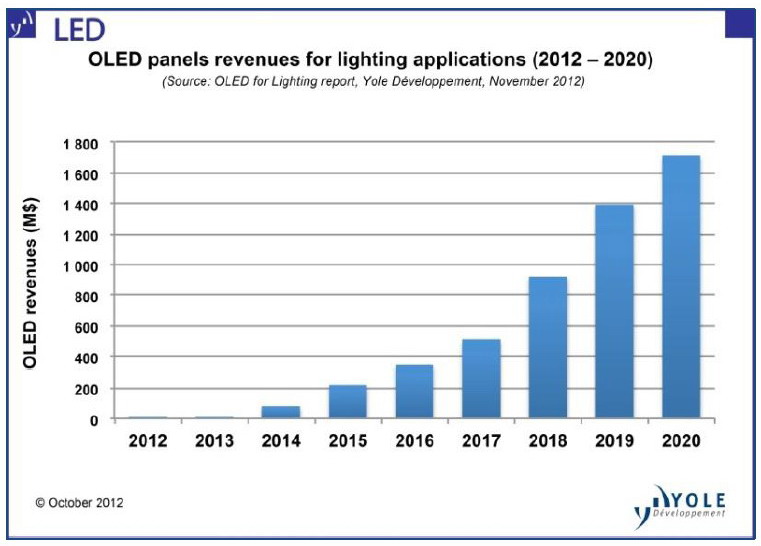So far, OLED revenue has been driven mainly by display applications but the industry is now targeting the lighting market based on the technology specificities in terms of design and efficiency.
In its new report "OLED for Lighting", Yole Développement presents all OLED Lighting applications and associated market metrics for the period 2012-2020. As the market research firm puts it, the OLED industry is just entering the lighting market, and on this new battleground, OLED will have to compete with LED technology which has already paved the way with a revolution in Solid State Lighting (SSL). The high cost of OLED technology will not make mass market penetration easier and current low efficacy could slow its adoption. OLEDs will develop slowly in the lighting market and attract mainly niche applications, differentiating through design possibilities. To access traditional market segments such as commercial lighting or office lighting, OLED technology will have to find a spark, as well as combine enough different niche markets to achieve the economies of scale that will decrease costs. In Yole Développement estimation, this should be triggered by 2014 with the use of larger substrates and better process control.

"OLED lighting panels will reach a market size of nearly $2.8M in 2012 and will peak to nearly $1.7B by 2020", estimates Pars Mukish, Technology & Market Analyst, LED & OLED at Yole Développement. Growth will be driven mainly by general lighting applications, representing more than 70% of the overall OLED Lighting Business in 2020.
Which technology approaches can drive OLED into mass production?
As for any emerging technology, a large variety of materials and OLED structures are used in production or tested. Moreover, alternatives to existing materials are still actively researched in order to improve the light performance, lifetime, and decrease manufacturing costs. Although the uncertainty about the future winning material approach between small-molecule OLED materials and polymer materials remains, polymers continue to struggle to demonstrate the ability to turn their cost and performance potential into an industrial reality.
Rigid glass maintains its exclusivity as a substrate material in OLED lighting panel production. However, progress has been made in the development of techniques, such as roll-to-roll processing, flexible ultra-thin glass and encapsulation solutions, which will enable the progressive penetration of flexible OLED panels into the lighting market. The wide variety of technology approaches provides opportunity for numerous players involved in OLED research & development activities. However, the identification of winning technology approaches and the precise identification of the corresponding time-to-market are essential for the successful development of the OLED lighting business. "To fully compete with LED technology and obtain the full benefits of OLEDs at a reasonable cost, new business models are mandatory. The traditional lighting industry will be reluctant to integrate new technology as it could eat away its own margins: OLED cost directly impacts the cost of OLED-based luminaires", explains Milan Rosina, Technology & Market Analyst, OLED & Photovoltaics at Yole Développement. These players will also have to integrate technology for which they have no know-how and which is outside of their expertise.
So the question is: will these players be ready to accept decreases in revenue and increases in production difficulty simply to aid the deployment of a new technology? The logical answer is no. For that reason, the development of OLED technology in the lighting market will be difficult and will force actors at the bottom of the supply chain to realize vertical integration in order to push the technology on the market. But accessing distribution channels will represent a big challenge for those players who will have to develop new approaches to sell their lighting products. The rise of OLED lighting will therefore depend on the right merger of the emerging OLED industry with the traditional lighting industry. Moreover, for General Lighting, the main challenge for OLEDs will be to identify the "spark" market that will allow the technology to develop economies of scale and to create a marketing window conveying advantages and possibilities of the technology toward consumers.





